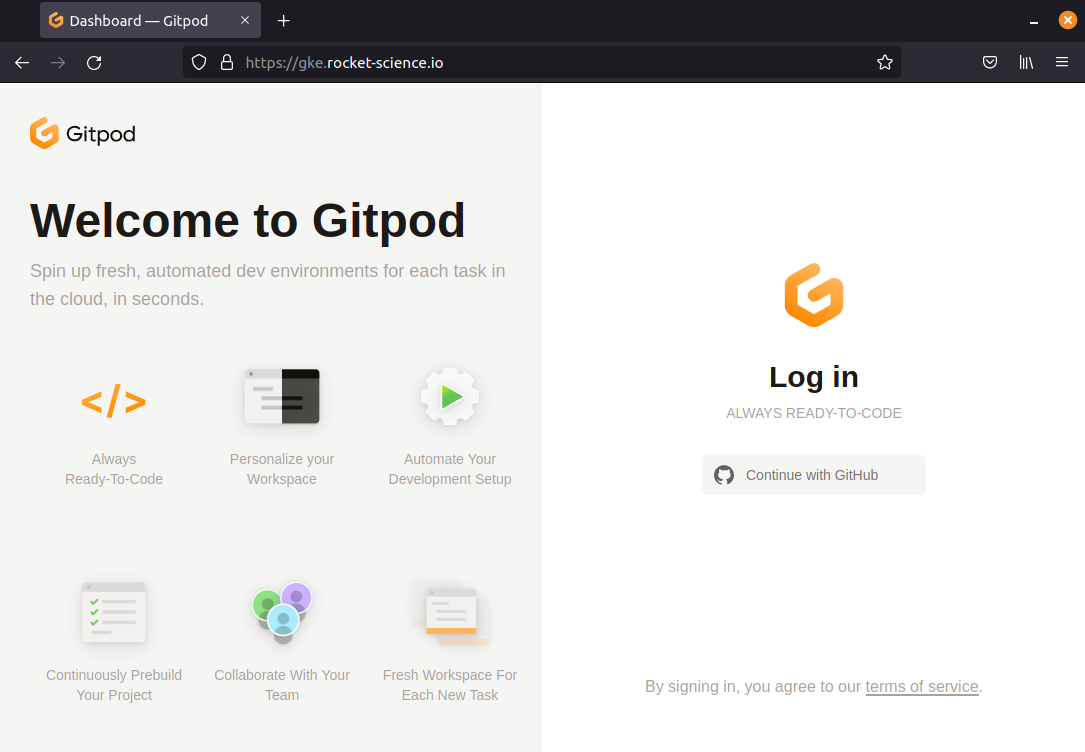Running Gitpod in Google Kubernetes Engine
Before starting the installation process, you need:
- A GCP account with Administrator access
- GCP credentials set up. Install gcloud
- A
.envfile with basic details about the environment.- We provide an example of such file here.
- Docker installed on your machine, or better, a Gitpod workspace :)
To start the installation, execute:
make installThe whole process takes around twenty minutes. In the end, the following resources are created:
- a GKE cluster running Kubernetes v1.21 (rapid channel).
- GCP L4 load balancer.
- Cloud SQL - Mysql database.
- Cloud DNS zone.
- In-cluster docker registry using Cloud Storage as storage backend.
- calico as CNI and NetworkPolicy implementation.
- cert-manager for self-signed SSL certificates.
- Jaeger operator - and Jaeger deployment for gitpod distributed tracing.
- gitpod.io deployment.
-
Insufficient regional quota to satisfy request
Depending on the size of the configured
disks sizeandmachine-type, it may be necessary to request an increase in the service quotaAfter increasing the quota, retry the installation running
make install -
Some pods never start (
Initstate)❯ kubectl get pods -l component=proxy NAME READY STATUS RESTARTS AGE proxy-5998488f4c-t8vkh 0/1 Init 0/1 0 5m
One of the reason could be related to the DNS01 challenge validation for the wildcard certificates can take several minutes (DNS propagation). So, once the Certificate is
Ready, maybe it will be needed to restart the deployments. The DNS01 challenge needs create a TXT record on the domain name. If the domain name is not in thePROJECT_NAME, this will need to be done manually. TheSETUP_MANAGED_DNSshould be set tofalse.❯ kubectl get certificate NAME READY SECRET AGE proxy-config-certificates True proxy-config-certificates 5m
running the commands:
kubectl rollout restart deployment/server kubectl rollout restart deployment/ws-proxy
First, check that Gitpod components are running.
kubectl get pods
NAME READY STATUS RESTARTS AGE
blobserve-6bdb9c7f89-lvhxd 2/2 Running 0 6m17s
content-service-59bd58bc4d-xgv48 1/1 Running 0 6m17s
dashboard-6ffdf8984-b6f7j 1/1 Running 0 6m17s
image-builder-5df5694848-wsdvk 3/3 Running 0 6m16s
jaeger-8679bf6676-zz57m 1/1 Running 0 4h28m
messagebus-0 1/1 Running 0 4h11m
proxy-56c4cdd799-bbfbx 1/1 Running 0 5m33s
registry-6b75f99844-bhhqd 1/1 Running 0 4h11m
registry-facade-f7twj 2/2 Running 0 6m12s
server-64f9cf6b9b-bllgg 2/2 Running 0 6m16s
ws-daemon-bh6h6 2/2 Running 0 2m47s
ws-manager-5d57746845-t74n5 2/2 Running 0 6m16s
ws-manager-bridge-79f7fcb5-7w4p5 1/1 Running 0 6m16s
ws-proxy-7fc9665-rchr9 1/1 Running 0 5m57sWhen the provisioning and configuration of the cluster is done, the script shows the URL of the load balancer, like:
Load balancer IP address: XXX.XXX.XXX.XXXPlease open the URL https://<domain>/workspaces.
It should display the gitpod login page similar to the next image.
DNS propagation can take several minutes.
Please check the OAuth providers integration documentation expected format.
We provide an example here. Fill it with your OAuth providers data.
make authWe are aware of the limitation of this approach, and we are working to improve the helm chart to avoid this step.
Remove the GCP cluster running:
make uninstallThe command asks for a confirmation:
Are you sure you want to delete: Gitpod (y/n)?
Please make sure you delete the GCP buckets used to store the docker registry images and Cloud SQL database!

